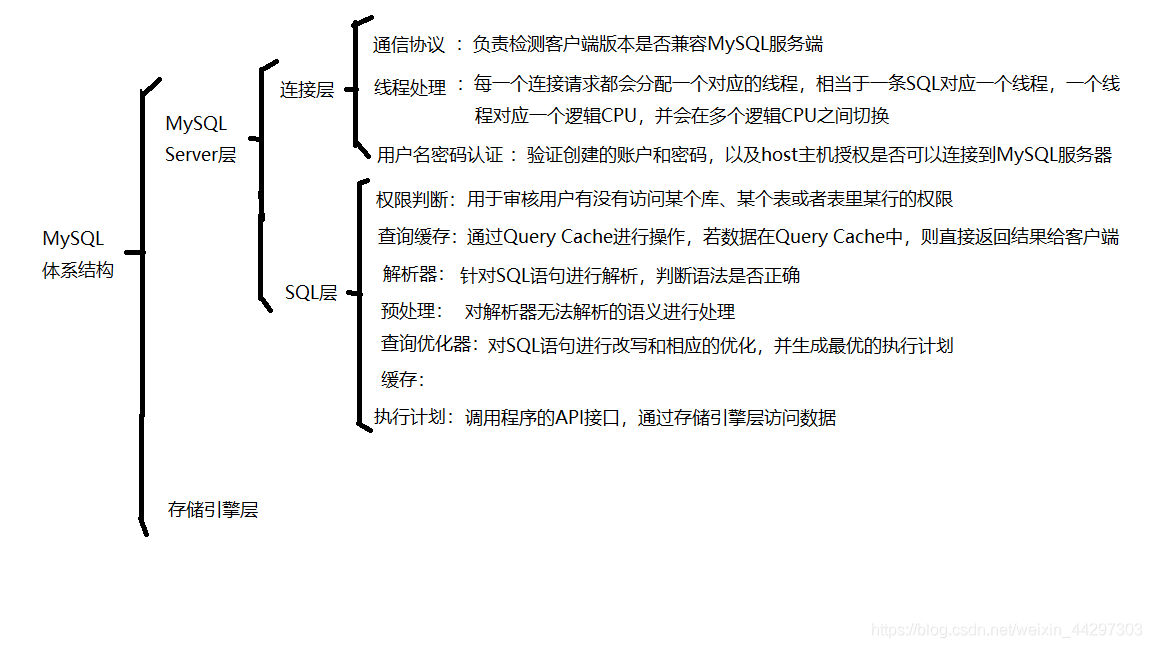A, MySQL architecture
I use a tree diagram to show the plain of MySQL architecture
From the figure can be seen the MySQL MySQL Sever architecture is divided into layers and layers storage engine, and the broken down, and the function

Two, Query Cache Detailed
- Query Cache is recommended in the production shut down, it can only cache static data, once the data changes, and often read and write, Query Cache becomes insufficient
- General Data Warehouse and the like can be considered open Query Cache
- MySQL5.6 previous version enabled by default Query Cache, after the default of 5.6 Close
1, introduce a stress test software sysbench
- sysbench is an open source, modular, cross-platform multi-threaded performance testing tool used to conduct performance tests CPU, memory, disk I / O, threads, database
- Package Download: https://downloads.mysql.com/source/sysbench-0.4.12.14.tar.gz
sysbench installation process
# tar -zxf sysbench-0.4.12.14.tar.gz
# cd sysbench-0.4.12.14/
# ./configure --with-mysql-includes=/usr/local/mysql/include --with-mysql-libs=/usr/local/mysql/lib
# make && make install
# find / -name 'libmysqlclient*' #找到libmysqlclient.so.20文件做一个软链接
# ln -s /usr/local/mysql-5.7.26-linux-glibc2.12-x86_64/lib/libmysqlclient.so.20 /usr/local/lib/libmysqlclient.so.20
# vim /etc/ld.so.conf
/usr/local/lib
# /sbin/ldconfig -v
2, how to completely close the Query Cache
Query Cache completely shut down core parameters need to focus on two:
the following:
root@localhost [(none)]>show variables like "%query_cache_size%";
- The query_cache_sizes set to 0 and is set to OFF query_cache_type

root@localhost [(none)]>show variables like "%query_cache_type%";

Third, the storage engine
The most mainstream of two engines: InnoDB and MyISAM, now the default database storage engine is InnoDB
1, InnoDB architecture
数据库:MySQL数据库是一个单进程多线程模型的数据库
数据库实例:进程加内存的组合
就比如一个杯子里装了水,杯子相当于数据库,水就相当于数据库实例
- InnoDB体系结构由内存结构、线程、磁盘文件组成,以下细讲
2、InnoDB存储结构
InnoDB逻辑存储单元主要分为表空间、段、区和页
a)表空间
- InnoDB存储引擎表中的所有数据都存放在表空间中
- 表空间分为系统表空间和独立表空间
系统表空间:以ibdata1来命名,在安装数据库初始化时就是系统在建立一个ibdata1的表空间文件,它会储存所有数据的信息以及回滚段(undo)的信息
- 数据库默认的ibdata1的大小是10M,在遇到高并发事物时,会受到不小的影响,建议将ibdata1的大小调整到1G
独立表空间:默认使用独立表空间文件,每个表有自己的表空间文件不用储存在ibdata1中
- 储存 对应表的B+树数据、索引和插入缓冲
- 每个表都有自己的表空间,可以实现表空间的转移,回收表空间方便
- 缺点是每个表文件都有.frm和.ibd文件两个文件描述符,如果单表增加过快就容易出现性能问题
共享表空间:数据和文件放在一起管理
- 无法在线回收空间,回收空间的将全部InnoDB表中的数据备份,删除原表,然后再把数据导回到与原表结构一样的新表中
b)段
- 表空间由段组成,也可以将一个表理解成4个段
- 每个段由N个区和32个零散的页组成
- 段空间扩展以区为单位扩展
- 一般来说,创建一个索引同时会创建两个段(非叶子节点和叶子节点段)
- 一个表有四个段,是索引个数的两倍
c)区
- 区有连续的页组成的,在物理上是连续分配的一段空间,每个区的大小固定是1M
d)页
- InnoDB的最小物理存储分配单位是page
- 一般来说,一个区由64个连续的页组成,页的默认大小为16K
- 一个page页会默认预留1/16的空间用于更新数据。真正使用的是15/16的空间
e)行
-
页里面记录着行记录的信息
-
InnoDB存储引擎面向的是行,也就是数据是按照行存储的
-
行记录数据按照行格式进行存放
-
有两种文件格式,Antelope和Barracuda
-
Antelope有compact和redundant两种行记录格式
-
Barracuda有compressed和dynamic两种行记录格式
-
5.7默认使用 dynamic行记录格式和 Barracuda文件格式
-
行溢出:
需要存储的数据在当前储存界面之外,拆分到多个页进行储存 -
目前生产环境中建议使用dynamic行记录格式进行存储
3、Buffer状态及其链表结构
-
page是InnoDB磁盘I/O的最小单位,数据存放在page中,对应到内存就是一个个buffer
-
buffer有三种状态:
free buffer:这个状态下的buffer没有被使用,是空闲的。但是在生产环境中,数据库很繁忙的情况下,free buffer基本不存在
clean buffer:内存中buffer里的数据和磁盘中page的数据一致
dirty buffer:内存中新写入的数据还没有刷新到磁盘,uffer里的数据和磁盘中page的数据不一致 -
buffer在内存中,需要被chain(链)组织起来
-
InnoDB是双向链表结构,由三种不同的buffer状态衍生出三条链表
free list:把free buffer都串联起来。数据库跑起来的时候,每次把page调到内存中,都会判断free buffer是否够用,不够用的话从lru list和flush list中释放free buffer
lru list:把与磁盘数据一致,并且最近最少被使用的buffer串联起来,释放出free buffer
flush list:把dirty buffer串联起来,方便刷新线程将脏数据刷到磁盘。规则是将那些最近最少被弄脏的数据串起来,刷新到磁盘后,释放出更多的free buffer
4、各大刷新线程及其作用
a)master thread线程
后台线程中的主线程,优先级别最高
内部有四个循环:
- 主循环loop
- 后台循环backgroud loop
- 刷新循环flush loop
- 暂定循环suspend loop
根据数据的运行状态在这四个循环之间进行切换
- 主循环loop中包含了每1s和每10s的操作
- 每1s操作:
1、日志缓冲刷新到磁盘,即使这个事务还没有被提交
2、刷新脏页到磁盘
3、执行合并插入缓冲的操作
4、产生checkpoint
5、清除无用的table cache
6、如果当前没有用户活动,就可能切换到background loop - 每10s操作:
1、日志缓冲刷新到磁盘,即是事务还没有被提交
2、执行合并插入缓冲操作
3、刷新脏页到磁盘
4、删除无用的undo页
5、产生checkpoint
b)四大I/O线程
read/write thread:数据库的读写请求线程,默认值是4个,如果使用高转速磁盘,可适当调大该值
redo log thread:把日志缓存中的内容刷新到redo log文件中
change buffer thread:把插入缓存(change buffer)中的内容刷新到磁盘中
c)page cleaner thread
负责脏页刷新线程,可增加多个
d)purge thread
负责删除无用的undo页
- 由于进行DML语句操作都会生成undo,系统需要定期对undo页进行清理,这时就需要purge操作
- purge默认线程个数是1个,最大可调整至32个
e)checkpoint线程
在redo log发生切换时,执行checkpoint。
redo log 发生切换或文件快写满时,会触发把脏页刷新到磁盘,确保redo log刷新到磁盘,实现真正的持久化,避免数据丢失
- error monitor thread :负责数据库报错的监控线程
- lock monitor thread :负责锁的监控线程
5、内存刷新机制
MySQL这种关系型数据库,讲究日志先行策略,就是一条DML语句进入数据库之后,先写日志,再写数据文件
a)redo log
redo log 又称重做日志文件,用来记录事务操作的变化,记录数据修改之后的值,不管事务是否被提交,都会被记录下来
- 在实例和介质失败时,如数据库掉电,这时候InnoDB存储引擎会使用重做日志,恢复到掉电前的时刻
默认情况至少有两个redo log文件,在磁盘用ib_logfile(0-N)来命名

-
redo log 写的方式是顺序写、循环写
顺序写、循环写是什么意思呢?
也就是说,第一个文件写满之后,写第二个文件,这样依次写到最后一个文件,直至最后一个文件写满之后,又重新写第一个文件,就这样循环 -
写满日志文件会产生切换操作,并执行checkpoint,触发脏页的刷新
-
数据库重启过程中,如果参数文件中的redo log值大小和当前redo log值大小不一致,那就删除当前redo log文件,按照参数文件中的redo log值大小,生成新的redo log文件
在生成redo log之前,数据写在redo log buffer中

redo log buffer刷新到磁盘的条件:
(1)通过innodb_flush_log_at_trx_commit 参数来控制
-
0:redo log thread 每隔1s会将redo log buffer中的数据写入redo log中,同时进行刷盘操作
每次事务提交并不会触发redo log thread 将日志缓冲中的数据写入redo log中去 -
1:每次事务提交时,都会触发redo log thread 将日志缓冲中的数据写入redo log,并flush到磁盘
-
2:每次事务提交时,把redo log buffer的数据写入redo log中,不刷到磁盘
这三种模式:0的性能 最好,但不安全,有丢失1s的数据的风险。1的安全性最高,不会丢失任何已经提交的事务,但就是数据库的性能最慢。2介于两者之间

(2)master thread :每秒进行刷新
(3)redo log buffer:使用超过一半的时候就触发刷新
b)binlog
MySQL的二进制文件,用于备份恢复和主从复制
-
从binlog cache刷新到磁盘binlog文件中所需条件:
sync_binlog=0时,当事务提交后,MySQL不做fsync之类的磁盘同步指令、将binlog_cache中的信息刷新到磁盘,而是让Filesystem自行决定什么时候来做同步,或cache满了之后,才同步到磁盘
sync_binlog=n时,每进行n次事务提交后,MySQL进行一次fsync之类的磁盘同步指令、将binlog_cache中的信息刷新到磁盘 -
sync_binlog设置为1,更安全
-
sync_binlog设置为0,性能最好
c)redo log 和 binlog的区别
redo log 和 binlog都记录了数据真实修改的语句,那他们为何要并存呢?
-
1、记录内容不同
binlog是逻辑日志,记录所有数据的改变信息
redo log是物理日志,记录所有InnoDB表数据的变化 -
2、记录内容的时间不同
binlog记录commit完毕之后的DML和DDL SQL语句
redo log记录事务发起之后的DML和DDL SQL语句 -
3, document use different
binlog is not recycled, or filled in after the restart instance, will generate a new binlog file
redo log is recycled, after the last file is full, it will re-write the first file -
4, the role of the different
binlog can be used as resume data, the master copy from the build
redo log data as a medium abnormality or failure recovery using downtime
d) dirty page refresh condition
- 1, after the redo log file filled ib_logfile, in the process of switching will perform the checkpoint, triggers the flushing dirty pages
- 2, innodb_max_dirty_pages_pct parameter control, which means the percentage of dirty page in buffer pool, the value reached, it will trigger the dirty page refresh

- 3, innodb_adaptive_flushing control parameters, which influence the number of dirty pages per second refresh, enabled by default

6, InnoDB three properties
-
1, insert buffer
the ordinary index DML operations from then on I / O into sequential I / O, to improve I / O efficiency
principle is: first determine whether the inserted ordinary index page in the buffer pool, the directly inserted, not placed on the first change buffer, the merge operation and the ordinary index change buffer, may be incorporated into a plurality of insertion operation, to improve the performance of the ordinary index insert -
2, two write (double write)
to ensure the safety of written when the MySQL instance to prevent the occurrence of downtime, InnoDB data page partial page write problem occurs if the page is damaged, redo log can not be recovered, so the need for a copy of the page, if the instance is down, first by a copy of the original page restore them, and then recover by redo log, redo -
3, the adaptive hash index